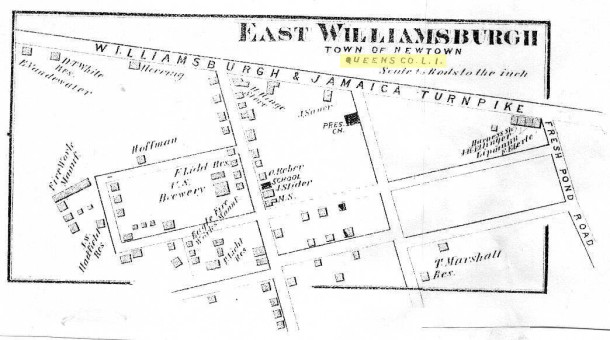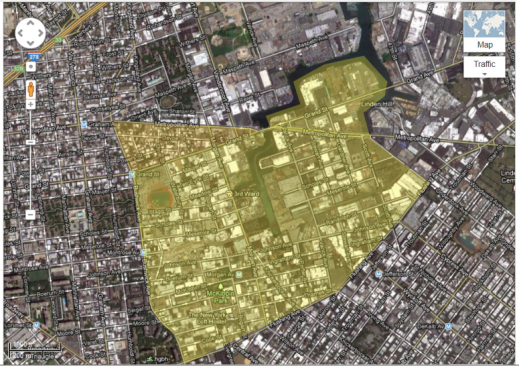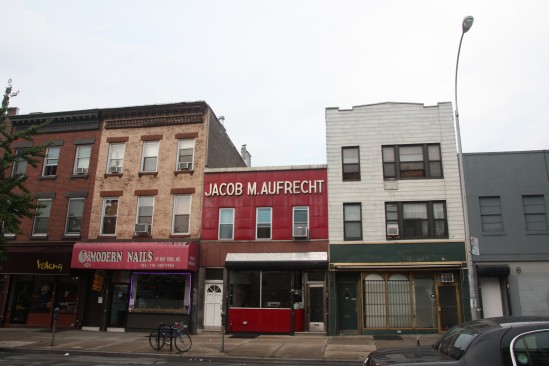Would a neighborhood by any other name smell as sweet? Or would apartments cost as much? It’s a touchy question to put to residents of Williamsburg, Bushwick, and—depending on your politics—East Williamsburg.
A cursory glance at the comments following an article with even the briefest mention of East Williamsburg reveals how easily the moniker stokes passions. Just note the vitriol in this response to a Gothamist article about a biker gang:
“East Williamsburg is a fiction sold by real estate agents, owners and marshmallow transplants who desperately want to tell people they live in Williamsburg. Don’t believe the gentrification hype.”
So how are neighborhood names born, rejected, codified, vilified or finally accepted? What’s at stake in the process? Is East Williamsburg an actual place, or is it merely the twinkle in a broker’s eye?
Well, it’s complicated.
New York is not a city that has official neighborhoods or neighborhood boundaries, so area names often become tools in the hands of city planners, developers and community groups. Some neighborhoods are enshrined as historic landmark districts, such as Vinegar Hill, but those with no officially recognized status can be contentious. “It becomes possible to imbue neighborhood names with a lot more meaning than if those boundaries were laid down in an official way,” explained Julie Golia, public historian for the Brooklyn Historical Society. “It can come to represent ethnic or racial strife, and gentrification.”
What has come to be referred to as East Williamsburg is an arrowhead-shaped area bounded by Flushing Avenue (with Bushwick on the other side) to the southeast, Bushwick Avenue to the west (though many folks who live on Graham Avenue, even some as far west as Union Avenue, consider that East Williamsburg) and Metropolitan Avenue to the north. It includes the East Williamsburg Industrial Business Zone, an irregular tail on the top of the arrowhead comprised of heavy industry around the terminus of Newtown Creek, and even a few of the stops on our Total Bushwick Immersion with Brooklyn Brewery.
Whether this is a real neighborhood depends on who you ask. According to John Manbeck, author of “Neighborhoods of Brooklyn,” East Williamsburg is a developer’s gentrification, just as Coney Island was renamed West Brighton in the late 1800s in an effort to sell homes in what was considered a seedy area. “In the future, you may find Brooklyn splintered into 200 to 500 neighborhoods, none of them official,” he said.
This codependent phenomenon of gentrification and creative neighborhood names is nothing new in New York City. As recently as the 1950s, Cobble Hill, Carroll Gardens and Boerum Hill didn’t even exist; they were collectively referred to as South Brooklyn. In this particular case, Golia said, brownstoners created the names in the interest of rebranding the neighborhood.
On the flip side, neighborhood names can also fall out of fashion and quietly drop from use. The notoriously lawless Pigtown, described by The Brooklyn Eagle in 1902 as “a lowland of romancing pigs, goats and shanties,” is now known as Prospect Lefferts Gardens and East Flatbush. Former New York Mayor Rudolph Giuliani called Pigtown home until age 7, when his family relocated to Long Island.
“The way I see it, New York City has been—and still is—in a constant state of flux,” said Heather Letzkus, proprietress of the Greenpoint-based blog NewYorkShitty. “As populations change, so do the neighborhoods they call home.” Real estate agents certainly take advantage of this fluidity, and as Letzkus explained, they often stretch a neighborhood’s boundaries the same way they stretch a renter’s budget. “If someone says his or her budget is $1,000 per month, the broker will assume it is actually $1,200,” she said. “As for neighborhoods, if you say Greenpoint, you may very well be shown an apartment in Ridgewood.”
The term East Williamsburg though, wasn’t invented by real estate agents. Originally, in fact, it wasn’t even located in Brooklyn. The earliest mention of the neighborhood, then part of the Dutch Newtown settlement, is found on maps dating from 1783 in the western chunk of what is now Ridgewood, Queens. Later, what some would call East Williamsburg today was home to a neighborhood known as Cripplebush, located roughly where Flushing and Nostrand Avenues intersect.
Pinpointing exactly when the name East Williamsburg came on the scene in the modern sense is tricky, but the commonly held belief is that the moniker was part of common parlance by the 1990s. “I recall seeing an article on ‘East Williamsburg’ in the Times as early as 1986,” said Golia, of the Brooklyn Historical Society. (There are multiple reference to “East Williamsburg” in The Times’ archives from the mid- to late-1800s, then the term re-emerges, as Golia correctly remembered, in 1986.) “I don’t know about a particular event that took place that prompted the use, but you could trace Williamsburg’s most embryonic gentrification roots back to the 1980s or early 1990s. That’s certainly a part of it.”
Another influence could have been the establishment of the East Williamsburg Industrial Business zone, created in 1982, and certainly not with the goal of selling luxury condos. Michael Rochford, its executive director, said that he and colleague Henry von Dam simply made up the moniker. “We needed to distinguish between South Williamsburg, Southside, Central Williamsburg and the Northside,” Rochford explained. “I never heard it used before then because up until the 1980s, it was considered Bushwick.” Rochford said that the redrawing of the community board district lines in the late 60s and early 70s likely also played a role, but that he continues to be surprised that the term now identifies such a broad portion of the neighborhood beyond the industrial business zone boundaries.
“I really think the ‘East’ isn’t meant as anything more than a general orientation,” Jeremy Sapienza, founder of the blog BushwickBK, explained by email. “It’s simply the eastern part of Williamsburg, which is pretty large and I think earns such a designation.” Williamsburg has a Northside and Southside, after all, neither of which seem to draw much attention from the neighborhood name police. “I live in Williamsburg. The east part. It’s not really seen as separate, but then that again depends on the times, the community, the individual you ask.”
Things get even fuzzier when you include Bushwick in this discussion, which technically stops at Flushing, but in the last decade has enveloped a section around the Morgan Ave. L stop–what some locals now call “Morgantown.” “Once I cross Johnson, I have a hard time saying something is in Bushwick,” said Sapienza. “I won’t be annoyed if someone else does, at least until they hit Grand. Then you’re in East Williamsburg.” (For more on the Morgantown boom and the consequences of name-brand neighborhood recognition, check out this BB interview with Chloë Bass, co-lead organizer for Arts in Bushwick, which produces Bushwick Open Studios.)
On a recent stroll down Graham Avenue–an area many would solidly identify as East Williamsburg–local takes on the contested neighborhood varied widely, perhaps predictably.
“To me, Williamsburg is Williamsburg,” said Phil Camporese, 43, who owns a hardware store at the corner of Grand and Humboldt and has lived in the neighborhood all his life.
Others agreed that the neighborhood exists, but didn’t have a concrete sense where it begins and ends. “East Williamsburg is definitely a real place,” said Anthony Santangelo, 41, a co-owner of Fine Wines and Liquors on Graham Ave. “But if you were to ask me the exact boundaries, I wouldn’t be able to tell you.”
It seems the only final word on a neighborhood name, and its boundaries, comes from a designation as a National Historic District. Cobble Hill, Carroll Gardens, Boerum Hill and even Greenpoint all have landmarked historic districts. East Williamsburg, on the other hand, will likely never receive that kind of distinction, due to the number of industrial buildings and older factories mixed in with structures of more conventional historical interest.
“There is absolutely a case to make for East Williamsburg landmark status,” said Golia. “Probably the primary argument is its fascinating industrial history. It could totally happen, but it’s easier to pitch a neighborhood with fine architecture and a rich cultural history than one where people might see rundown buildings.”
In the end, whether an area is called Cripplebush, Pigtown, Bushwick, or East Williamsburg, the real measure of a community is the relationships between people who live there. “If you love where you live, have neighbors who know you, support you and take care of you in times of need, who the hell cares where the place is or what it’s called?” said Letzkus. “It’s simply home.”





thanks! this is a fantastic idea for a series.
thank you for including that map. for years, whenever someone remarks that “East Williamsburg” is just something that the real estate agents created to sell condos, i’ve always retorted that maps from the 1800’s have East Williamsburg clearly labeled. i don’t care if you call it Williamsburg or East Williamsburg, but just do NOT call it Bushwick. having been a resident of Bushwick for almost a decade, i can tell you that the Bushwick i live in to the south/ east of Flushing is a completely different beast than what you find on the other side of the street. so many people are so eager to rep Bushwick these days, it’s actually kind of weird.
Oh please, calling that area West Bushwick is more accurate than calling it East Williamsburg. Sick and tired of all the gentrification. All the families that lived in that area were all connected from both sides of Flushing. Growing up in Bushwick and i can tell you that calling that area East Williamsburg is an insult to the people who got pushed out that lived there for more than 20yrs. They wanna claim its part of Williamsburg well i say its West Bushwick.
THANK YOU for this. It drives me bats when people try to tell me East Williamsburg is something brokers made up or when they say “248 Mckibbin? That’s not East Williamsburg, it’s Bushwick” like they’re so effing clever. One step ahead of my sneaky, greedy *ss, are you? Boom. Department of City Planning Map: http://www.nyc.gov/html/dcp/pdf/neighbor/neighbor.pdf. The area west of Flushing is NOT Bushwick. Would people rather agents call it Williamsburg than East Williamsburg? See, I think THAT – while technically MORE ACCURATE than calling it Bushwick – would be misleading, no? Grar.
You weren’t even born in Brooklyn. A decade c’mon. West Bushwick is more accurate. That area has nothing to do with snobby Williamsburg.
I moved from Manhattan to “East Williamsburg” in 2007 to escape Manhattan’s high rents. Coworkers who grew up in the area told me even back then that “East Williamsburg” was a myth created by the real estate industry. Five years ago, the area was a safe, quiet Latino neighborhood with a lot of charm and friendly people who had lived there for decades. But soon the working-class Latino families were kicked out and yuppies moved in and ruined the area around Bushwick Avenue and Montrose/Meserole. I have since moved to Ridgewood, Queens because the rents in “East Williamsburg” went sky high. When I was looking for a new place, I was shocked that they were calling areas like the Halsey St. L train stop “East Williamsburg.” Thanks for the great article.
Thank you for your honest comment this is proof on what others are saying isn’t true. They wanna call it “East Williamsburg” well i call it West Bushwick. Williamsburg has nothing to do with the way that area is over the years, besides all the snobs coming into the area making false gentrified claims .
are the references in the 1980’s to east williamsburg referring to what we refer to now? that’s the only thing that isn’t clear to me.
east williamsburg should have it’s own name because it is different than the neighborhoods that surround it. but in this map from 1943 (http://www.1940snewyork.com/) it has a separate name, and it’s labeled as English Kills. when did that fall out of fashion and why?
As one of the first gentrifiers to the Bogart St lofts (before the chop shop guys built Brooklyn Natural in the back of the garage) I can tell you that while our broker tried to convince us the neighborhood was in the ‘East Williamsburg Industrial Park,’ in my heart of hearts, it will always be “West Bushwick Hills Estates.”
GENTRIFICATION of BROOKLYN: On February 27, 2014, Joshua Greenman – a Jewish gentrifier and employee of New York Daily News – gets taken to task by BPR’s DC Livers after his article on Spike Lee calling out gentrifies goes wrong. WHITE FOLKS WANT TO WASH AWAY ALL THAT MAKES BROOKLYN “BROOKLYN” in push for gentrification.
INSIDE THE MIND OF A GENTRIFIER: New York reporter racked with guilt for racial gentrification of Brooklyn attacks Spike Lee in article gets defensive when BPR asks him to clarify his comments. LISTEN NOW as writer Joshua Greenman of the NY Daily News CRASHES and BURNS as he attempts to defend his position. Call 218-844-3182 use code 77103987.
*WARNING: The audio is real, raw and unedited so offensive words have not been omitted. *